- Home
- Carl Sagan
Broca's Brain Page 6
Broca's Brain Read online
Page 6
Clearly, there are more technological projects now possible than we can afford. Some of them may be extremely cost-effective but may have such large start-up costs as to remain impractical. Others may require a daring initial investment of resources, which will work a benevolent revolution in our society. Such options have to be considered extremely carefully. The most prudent strategy calls for combining low-risk/moderate-yield and moderate-risk/high-yield endeavors.
For such technological initiatives to be understood and supported, significant improvements in public understanding of science and technology are essential. We are thinking beings. Our minds are our distinguishing characteristic as a species. We are not stronger or swifter than many other animals that share this planet with us. We are only smarter. In addition to the immense practical benefit of having a scientifically literate public, the contemplation of science and technology permits us to exercise our intellectual faculties to the limits of our capabilities. Science is an exploration of the intricate, subtle and awesome universe we inhabit. Those who practice it know, at least on occasion, a rare kind of exhilaration that Socrates said was the greatest of human pleasures. It is a communicable pleasure. To facilitate informed public participation in technological decision making, to decrease the alienation too many citizens feel from our technological society, and for the sheer joy that comes from knowing a deep thing well, we need better science education, a superior communication of its powers and delights. A simple place to start is to undo the self-destructive decline in federal scholarships and fellowships for science researchers and science teachers at the college, graduate and postdoctoral levels.
The most effective agents to communicate science to the public are television, motion pictures and newspapers—where the science offerings are often dreary, inaccurate, ponderous, grossly caricatured or (as with much Saturday-morning commercial television programing for children) hostile to science. There have been astonishing recent findings on the exploration of the planets, the role of small brain proteins in affecting our emotional lives, the collisions of continents, the evolution of the human species (and the extent to which our past prefigures our future), the ultimate structure of matter (and the question of whether there are elementary particles or an infinite regress of them), the attempt to communicate with civilizations on planets of other stars, the nature of the genetic code (which determines our heredity and makes us cousins to all the other plants and animals on our planet), and the ultimate questions of the origin, nature and fate of life, worlds and the universe as a whole. Recent findings on these questions can be understood by any intelligent person. Why are they so rarely discussed in the media, in schools, in everyday conversation?
Civilizations can be characterized by how they approach such questions, how they nourish the mind as well as the body. The modern scientific pursuit of these questions represents an attempt to acquire a generally accepted view of our place in the cosmos; it requires open-minded creativity, tough-minded skepticism and a fresh sense of wonder. These questions are different from the practical issues I discussed earlier, but they are connected with such issues and—as in the example of Faraday and Maxwell—the encouragement of pure research may be the most reliable guarantee available that we will have the intellectual and technical wherewithal to deal with the practical problems facing us.
Only a small fraction of the most able youngsters enter scientific careers. I am often amazed at how much more capability and enthusiasm for science there is among elementary school youngsters than among college students. Something happens in the school years to discourage their interest (and it is not mainly puberty); we must understand and circumvent this dangerous discouragement. No one can predict where the future leaders of science will come from. It is clear that Albert Einstein became a scientist in spite of, not because of, his schooling (Chapter 3). In his Autobiography, Malcolm X describes a numbers runner who never wrote down a bet but carried a lifetime of transactions perfectly in his head. What contributions to society, Malcolm asked, would such a person have made with adequate education and encouragement? The most brilliant youngsters are a national and a global resource. They require special care and feeding.
Many of the problems facing us may be soluble, but only if we are willing to embrace brilliant, daring and complex solutions. Such solutions require brilliant, daring and complex people. I believe that there are many more of them around—in every nation, ethnic group and degree of affluence—than we realize. The training of such youngsters must not, of course, be restricted to science and technology; indeed, the compassionate application of new technology to human problems requires a deep understanding of human nature and human culture, a general education in the broadest sense.
We are at a crossroads in human history. Never before has there been a moment so simultaneously perilous and promising. We are the first species to have taken our evolution into our own hands. For the first time we possess the means for intentional or inadvertent self-destruction. We also have, I believe, the means for passing through this stage of technological adolescence into a long-lived, rich and fulfilling maturity for all the members of our species. But there is not much time to determine to which fork of the road we are committing our children and our future.
PART II
THE
PARADOXERS
CHAPTER 5
NIGHT WALKERS
AND MYSTERY MONGERS:
SENSE AND NONSENSE
AT THE EDGE
OF SCIENCE
PLANT’S HEARTBEAT THRILLS SCIENTISTS AT
OXFORD MEETING
Hindu Savant causes further sensation by
showing “blood” of plant flowing
AUDIENCE SITS ABSORBED
Watches with rapt attention as lecturer submits
snapdragon to death struggle
The New York Times
August 1, 1926, page 1
William James used to preach the “will to believe.”
For my part, I should wish
to preach the “will to doubt.”…
What is wanted is not the will to believe,
but the wish to find out, which is
the exact opposite.
BERTRAND RUSSELL,
Sceptical Essays (1928)
IN GREECE of the second century A.D., during the reign of the Roman Emperor Marcus Aurelius, there lived a master con man named Alexander of Abonutichus. Handsome, clever and totally unscrupulous, in the words of one of his contemporaries, he “went about living on occult pretensions.” In his most famous imposture, “he rushed into the marketplace, naked except for a gold-spangled loincloth; with nothing but this and his scimitar, and shaking his long, loose hair, like fanatics who collect money in the name of Cybele, he climbed onto a lofty altar and delivered a harangue” predicting the advent of a new and oracular god. Alexander then raced to the construction site of a temple, the crowd streaming after him, and discovered—where he had previously buried it—a goose egg in which he had sealed up a baby snake. Opening the egg, he announced the snakelet as the prophesied god. Alexander retired to his house for a few days, and then admitted the breathless crowds, who observed his body now entwined with a large serpent: the snake had grown impressively in the interim.
The serpent was, in fact, of a large and conveniently docile variety, procured for this purpose earlier in Macedonia, and outfitted with a linen head of somewhat human countenance. The room was dimly lit. Because of the press of the crowd, no visitor could stay for very long or inspect the serpent very carefully. The opinion of the multitude was that the seer had indeed delivered a god.
Alexander then pronounced the god ready to answer written questions delivered in sealed envelopes. When alone, he would lift off or duplicate the seal, read the message, remake the envelope and attach a response. People flocked from all over the Empire to witness this marvel, an oracular serpent with the head of a man. In those cases where the oracle later proved not just ambiguous but grossly wrong, Alexander
had a simple solution: he altered his record of the response he had given. And if the question of a rich man or woman revealed some weakness or guilty secret, Alexander did not scruple at extortion. The result of all this imposture was an income equivalent today to several hundred thousand dollars per year and fame rivaled by few men of his time.
We may smile at Alexander the Oracle-Monger. Of course we all would like to foretell the future and make contact with the gods. But we would not nowadays be taken in by such a fraud. Or would we? M. Lamar Keene spent thirteen years as a spiritualist medium. He was pastor of the New Age Assembly Church in Tampa, a trustee of the Universal Spiritualist Association, and for many years a leading figure in the mainstream of the American spiritualist movement. He is also a self-confessed fraud who believes, from first-hand knowledge, that virtually all spirit readings, séances and mediumistic messages from the dead are conscious deceptions, contrived to exploit the grief and longing we feel for deceased friends and relatives. Keene, like Alexander, would answer questions given to him in sealed envelopes—in this case not in private, but on the pulpit. He viewed the contents with a concealed bright lamp or by smearing lighter fluid, either of which can render the envelope momentarily transparent. He would find lost objects, present people with astounding revelations about their private lives which “no one could know,” commune with the spirits and materialize ectoplasm in the darkness of the séance—all based on the simplest tricks, an unswerving self-confidence, and most of all, on the monumental credulity, the utter lack of skepticism he found in his parishioners and clients. Keene believes, as did Harry Houdini, that not only is such fraud rampant among the spiritualists, but also that they are highly organized to exchange data on potential clients, in order to make the revelations of the séance more astonishing. Like the viewing of Alexander’s serpent, the séances all take place in darkened rooms—because the deception would be too easily penetrated in the light. In his peak-earning years, Keene earned about as much, in equivalent purchasing power, as Alexander of Abonutichus.
From Alexander’s time to our own—indeed, probably for as long as human beings have inhabited this planet—people have discovered they could make money by pretending to arcane or occult knowledge. A charming and enlightening account of some of these bamboozles can be found in a remarkable book published in 1852 in London, Extraordinary Popular Delusions and the Madness of Crowds, by Charles Mackay. Bernard Baruch claimed that the book saved him millions of dollars—presumably by alerting him to which idiot schemes he should not invest his money in. Mackay’s treatment ranges from alchemy, prophecy and faith healing, to haunted houses, the Crusades, and the “influence of politics and religion on the hair and beard.” The value of the book, like the account of Alexander the Oracle-Monger, lies in the remoteness of the frauds and delusions described. Many of the impostures do not have a contemporary ring and only weakly engage our passions: it becomes clear how people in other times were deceived. But after reading many such cases, we begin to wonder what the comparable contemporary versions are. People’s feelings are as strong as they always were, and skepticism is probably as unfashionable today as in any other age. Accordingly, there ought to be bamboozles galore in contemporary society. And there are.
In Alexander’s time, as in Mackay’s, religion was the source of most accepted insights and prevailing world views. Those intent on duping the public often did so in religious language. This is, of course, still being done, as the testimony of penitent spiritualists and other late-breaking news amply attest. But in the past hundred years—whether for good or for ill—science has emerged in the popular mind as the primary means of penetrating the secrets of the universe, so we should expect many contemporary bamboozles to have a scientific ring. And they do.
Within the last century or so, many claims have been made at the edge or border of science—assertions that excite popular interest and, in many cases, that would be of profound scientific importance if only they were true. We will shortly examine a representative sampling of them. These claims are out of the ordinary, a break from the humdrum world, and often imply something hopeful: for example, that we have vast, untapped powers, or that unseen forces are about to save us from ourselves, or that there is a still unacknowledged pattern and harmony to the universe. Well, science does sometimes make such claims—as, for example, the realization that the hereditary information we pass from generation to generation is encoded in a single long molecule called DNA, in the discovery of universal gravitation or continental drift, in the tapping of nuclear energy, in research on the origin of life or on the early history of the universe. So if some additional claim is made—for example, that it is possible to float in the air unaided, by a special effort of will—what is so different about that? Nothing. Except for the matter of proof. Those who claim that levitation occurs have an obligation to demonstrate their contention before skeptics, under controlled conditions. The burden of proof is on them, not on those who might be dubious. Such claims are too important to think about carelessly. Many assertions about levitation have been made in the last hundred years, but motion pictures of well-illuminated people rising unassisted fifteen feet into the air have never been taken under conditions which exclude fraud. If levitation were possible, its scientific and, more generally, its human implications would be enormous. Those who make uncritical observations or fraudulent claims lead us into error and deflect us from the major human goal of understanding how the word works. It is for this reason playing fast and loose with the truth is a very serious matter.
ASTRAL PROJECTION
CONSIDER WHAT is sometimes called astral projection. Under conditions of religious ecstasy or hypnagogic sleep, or sometimes under the influence of a hallucinogen, people report the distinct sensation of stepping outside the body, leaving it, floating effortlessly to some other place in the room (often near the ceiling), and only at the end of the experience remerging with the body. If such a thing can actually happen, it is certainly of great importance; it implies something about the nature of human personality and even about the possibility of “life after death.” Indeed, some people who have had near-death experiences, or who have been declared clinically dead and then revived, report similar sensations. But the fact that a sensation is reported does not mean that it occurred as claimed. There might, for example, be a common experience or wiring defect in human neuroanatomy that under certain circumstances always leads to the same illusion of astral projection. (See Chapter 25.)
There is a simple way to test astral projection. In your absence, have a friend place a book face up on a high and inaccessible shelf in the library. Then, if you ever have an astral projection experience, float to the book and read the title. When your body reawakens and you correctly announce what you have read, you will have provided some evidence for the physical reality of astral projection. But, of course, there must be no other way for you to know the title of the book, such as sneaking a peek when no one else is around, or being told by your friend or by someone your friend tells. To avoid the latter possibility, the experiment should be done “double blind”; that is, someone quite unknown to you who is entirely unaware of your existence must select and place the book and judge whether your answer is correct. To the best of my knowledge no demonstration of astral projection has ever been reported under such controlled circumstances with skeptics in attendance. I conclude that while astral projection is not excluded, there is little reason to believe in it. On the other hand, there is some evidence accumulated by Ian Stevenson, a University of Virginia psychiatrist, that young children in India and the Near East report in great detail a previous life in a moderately distant locale which they have never visited, while further inquiry demonstrates that a recently deceased person fits the child’s description very well. But this is not an experiment performed under controlled conditions, and it is at least possible that the child has overheard or been given information about which the investigator is unaware. Stevenson’s work is probably the most int
eresting of all contemporary research on “extrasensory perception.”
SPIRIT RAPPING
IN UPSTATE NEW YORK in 1848 there lived two little girls, Margaret and Kate Fox, about whom marvelous stories were told. In their presence could be heard mysterious rapping noises, later understood to be coded messages from the spirit world: Ask the spirits anything—one rap signifies no, three raps signify yes. The Fox sisters became a sensation, embarked on nationwide tours organized by their elder sister, and became the focus of rapt attention from European intellectuals and literati such as Elizabeth Barrett Browning. The “manifestations” brought about by the Fox sisters are the origins of modern spiritualism, the belief that by some special effort of will a few gifted people are able to communicate with the spirits of the dead. Keene’s associates owe a substantial debt to the Fox sisters.

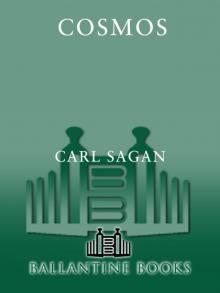 Cosmos
Cosmos Murmurs of Earth
Murmurs of Earth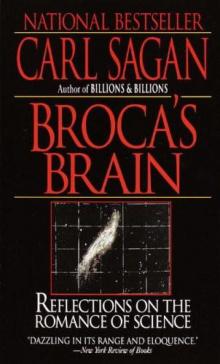 Broca's Brain
Broca's Brain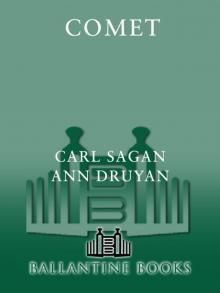 Comet
Comet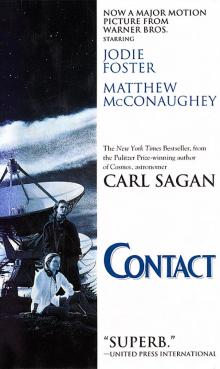 Contact
Contact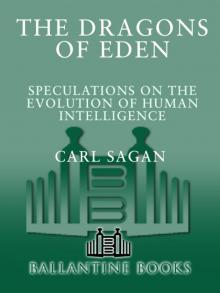 Dragons of Eden
Dragons of Eden Cosmic Connection
Cosmic Connection Shadows of Forgotten Ancestors
Shadows of Forgotten Ancestors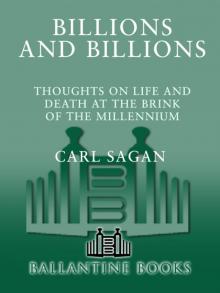 Billions & Billions
Billions & Billions Comet, Revised
Comet, Revised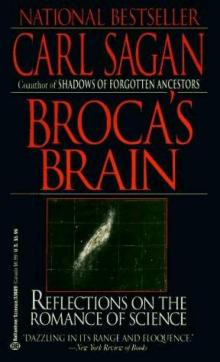 Broca's Brain: The Romance of Science
Broca's Brain: The Romance of Science The Varieties of Scientific Experience: A Personal View of the Search for God
The Varieties of Scientific Experience: A Personal View of the Search for God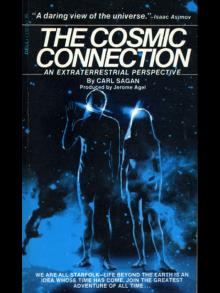 The Cosmic Connection
The Cosmic Connection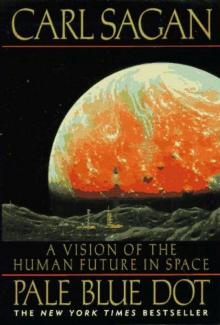 Pale Blue Dot: A Vision of the Human Future in Space
Pale Blue Dot: A Vision of the Human Future in Space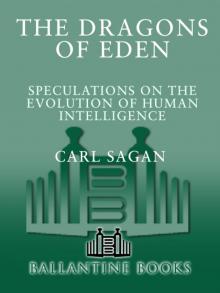 The Dragons of Eden
The Dragons of Eden